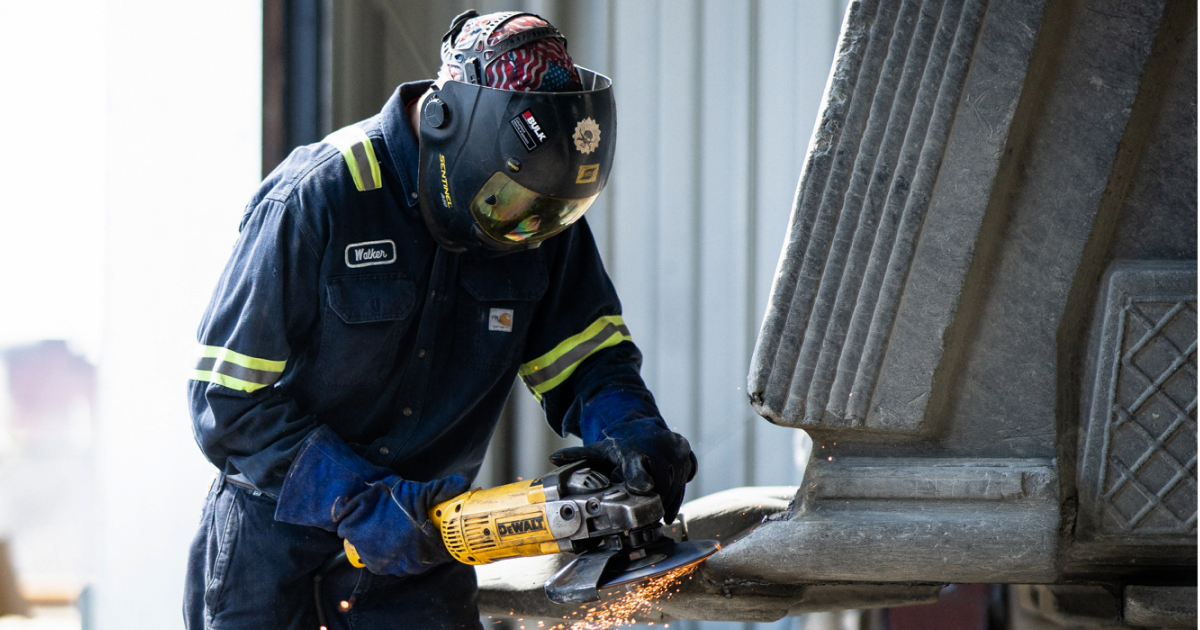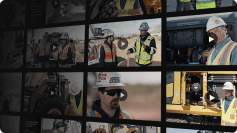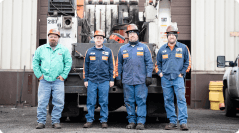What's the ROI on Training Management?
Written by Megan Hamilton
April 6, 2022

Training is necessary for your employees, but managing a training program can consume a lot of time and money. And that begs the question, “What’s the ROI?”
In other words, are you really getting results that are worth the money and time it takes to train?
To help you answer that question, let’s define ROI and see what's normal for construction training. Then, we’ll teach you how to measure your training program's ROI.
What is ROI?
ROI stands for return on investment. It’s a way to measure the value, efficiency, or profitability of something you’ve spent money on.
Business leaders use ROI to compare financial investments and purchases to see which one gives them the most bang for their buck.
You can also evaluate the ROI when you spend time, energy, or other resources. For instance, if an hour-long training seminar prevents an employee from getting hurt on the job, that’s a good ROI.
What's the typical ROI for construction training?
The Construction Industry Institute (CII) surveyed construction leaders who invested 1% of their labor budget on training. They found that on average:
- Productivity increased 11%.
- Turnover decreased 14%.
- Absenteeism decreased 15%.
- Rework decreased 23%.
- Injuries decreased 26%.1
Now, there are limits to surveys—like how many people respond or how accurately they report their ROI. However, the CII did some fancy math to weed out inaccurate answers. And the results are promising.
But what do your results look like? Are you getting this type of training ROI—or could you? To find out, you have to learn how to measure your training ROI.
What to consider when measuring training ROI
Understanding the ROI for training can be more complex than the ROI for purchasing or renting equipment. That’s because the value is more than just, “How much does this cost?” and “How much money can this tool make for me?”
Training ROI has to do with your team’s overall growth. And measuring that can be tricky, because costs may hide in other areas of the business—like payroll and productivity.
According to the Society for HR Management, the biggest metrics for determining the ROI on training are the overall cost and how practical the training is.2 However, there are other metrics to keep in mind.
Consider these four factors when measuring your training ROI.
1. How much does training cost?
Much like buying and operating equipment, you need to know how much training costs. Be sure to consider the four types of training costs: initial, maintenance, hidden, and future.
Initial costs
Initial costs are those you pay right away for a training event or product.
Let’s say you host a two-day training workshop, and you pay $3,500 for a trainer to instruct your employees, plus food and swag . That's the initial cost.
Here’s another example: training software. Most software companies charge a base price for the platform itself, plus usage costs.
Imagine you buy BuildWitt Training. It has a base price of $3,000, plus $10 per user license per month. So you’d pay $9,000 for a 50-person team to access the training software for a whole year.
Maintenance costs
Like machinery, training programs need maintenance. Maintenance costs are the recurring expenses you pay over time to keep your training program running, like:
- Onboarding training for each group of new hires
- OSHA refresher courses every three years
- Your training manager’s yearly salary
- Annual renewal fees for training software
You can see these costs coming, so even if the price varies a little, you can generally gauge how much program maintenance will cost you each year.
It’s smart to consider how long you plan to use your current training program and how often you pay for it. Then, you can spot any maintenance costs that start to creep up and threaten to lower your ROI.
Hidden costs
Hidden costs aren't obviously related to training. They often come in the form of payroll, productivity, and travel.
Consider that two-day training workshop we mentioned earlier. How much revenue will you lose when production stops for two days? How much will it cost you to bring the whole team to the training venue? That all factors into your ROI.
Now let’s try another one.
Say your foreman trains new hires on the job. While he’s teaching them, his payroll is a training expense. Plus, training new hires takes time away from his other tasks. The money you lose when your foreman is busy training people—instead of managing the project—is also a training expense.
Now, we’re not saying foremen shouldn’t train people. They should share their experience and help others grow. You just need to know what that costs.
If your foreman is losing too much time and money training Nevin the New Hire, then you should look for ways to improve your training program and get a better ROI.
Future costs
Future costs haven’t hit yet . . . but when they do, they will change your training ROI.
For example, let’s say you plan to grow your team by 20 people this year. Then you have to consider things like:
- How much will it cost to bring 20 more people to this year’s training workshop?
- How much will it cost to get them onboarded and OSHA-certified?
- How much will your software provider charge for another 20 user licenses?
- How much more will you have to pay training managers, foremen, and other leaders to help develop these new hires?
Future costs are important because they help you project the ROI of a growing training program.
Remember, doing what it takes to train your team well is worth the cost. You just want to make sure you’re getting the most bang for your buck.
2. How often will you use this training?
Frequent training helps you get a better ROI. But it’s important to be realistic about how much you and your employees will use your training program.
Consider how many people have access to the training. Is it everyone, or select people who are trying it out? Are those people doing their assignments? Those things play a huge role in your ROI.
So you want to make training as accessible as possible. If your training program is impractical or complicated, crew members won’t use it. Then you just wasted a bunch of money. So look for a program that’s engaging and easy to use—like software with short, interesting, easy-to-retain lessons.
In other words, to get the best ROI you need training that makes learning a positive experience—not a chore.
3. How much does not training cost you?
You might have put off training because you were worried about how much it cost . . . but have you ever considered the price you pay when you don’t train your people?
Lack of training causes big, expensive problems. But a training program with a good ROI helps you prevent these problems and saves you money. Take a look:
High turnover and absenteeism
High turnover is a critical problem in the Dirt World, and so is absenteeism. When someone quits unexpectedly or doesn’t show up, you have to draw people and resources from other areas, lowering productivity and leaving your crews scrambling.
There’s also the cost of hiring a replacement. It can cost roughly twice a person’s annual salary to replace them.3
A good training solution reduces turnover and increases retention. In fact, 94% of employees say they would stay longer at a company if that company invested in their careers.4
Rework and injuries
Crew mistakes are costly, and without proper training, they’re far more likely to happen. This leads to accidents, injuries, deaths, damaged equipment, lost productivity, rework, and high insurance rates.
All that from one mistake? Yep.
Any reportable safety accident can increase your experience modifier rate (EMR).5 That’s the number insurance companies use to decide how likely you are to file workers’ comp claims. A high EMR increases your premiums and can stop you from bidding on jobs that require a specific safety score.
Even if you foot the bill for a “non-safety” mistake, like a missed grade or broken water line, these costly lessons cut profits and skew performance results.
Consider how much you paid to rework crew mistakes last year. What if training could help you cut that number? Wouldn’t it be cheaper to pay for training than to keep paying for mistakes?
4. How much more business could you do with good training?
Maybe you have the right equipment, but you don’t have enough people. Maybe you’ve got the people, but they don’t have the skills to safely take on the work. Either way, you’re missing out on revenue.
So, imagine you implement a training program to attract more workers and upskill them. With your newly trained, high-performing team, you win bids for jobs that increase your revenue by 10% this year. That’s part of your training ROI, too.
It’s important to account for how training helps you expand your team and do more business.
How to measure ROI
We’ve talked about what to consider when you’re measuring training ROI. Now it’s time to talk about how.
Track your training costs
Tracking costs tells you how much money you lost due to turnover, absenteeism, rework, and injuries—and how much training saved you. Plus, you won’t know whether a new training program will save you money unless you know what you paid for the old one.
So you’ve got to track your costs based on the four factors we just talked about:
- How much the training costs
- How often you’ll use it
- How much not training costs you
- Revenue and business growth attributed to training
How you track that information is up to you. Do you conduct surveys? Collect data from department or crew leaders? Hand it over to your CFO? Whatever you do, be thorough and get help from the right people.
If you spending too much money in one area—say, turnover or machine downtime—pay extra attention. You can even calculate the training ROI for that specific area to show your leadership team how training can solve that particular business problem.
A formula to calculate the ROI on training
There’s an easy formula to calculate ROI on any investment, including training.
First, subtract the total training cost from the total monetary benefit of the training to get the net value. Then, divide the net value by the total training cost. Finally, multiply that number by 100 to get your ROI percentage.
|
ROI = |
$ benefit of training - $ cost of training |
x 100 |
|
$ cost of training |
Let’s look at how those numbers could play out for a contractor.
Bob owns a 50-person company with yearly labor costs of $3 million. He decides to invest 1% of that labor cost on training—like the construction leaders in the CII survey we talked about. So, Bob budgets $30,000 for training this year.
Now, the CII survey participants saw an average increase of 11% productivity when they budgeted like this. But let’s say Bob gets smaller results: his team’s productivity increases by 5%.
That 5% increase in productivity means Bob saves 5% on labor and equipment this year. So here’s how the math works out:
$3,000,000 labor + $1,282,000 equipment = $4,282,000 production costs*
$4,282,000 x 5% = $214,100
*Labor, equipment, and production costs are based on the average percentages from the Construction Financial Management Association.6
So, Bob saved $214,100 thanks to his new training program. Now let’s calculate Bob’s ROI using the formula from earlier.
Step 1:
|
ROI = |
$214,100 - $30,000 |
x 100 |
|
$30,000 |
Step 2:
|
ROI = |
$184,100 |
x 100 |
|
$30,000 |
Step 3:
|
ROI = |
6.13 |
x 100 |
Step 4:
|
ROI = |
613% |
|
That means Bob’s new training program saved him six times more money than he spent on it. That’s a good ROI!
Now, that’s just an example—but it’s pretty conservative. It doesn’t count how much money Bob saved on workers’ comp claims, insurance, or hiring replacements for people who quit. It also doesn’t count how much more money Bob can make now that his productivity has gone up. Including those factors would make his ROI even higher.
Your potential training ROI can be this good, or better. It all depends on what training you implement and its effectiveness.
That’s the great thing about training: to some extent, you decide what you want to get out of it and find ways to make it happen. The sky’s the limit!
Takeaways
Training is necessary for your workers, but you need to know you’re getting a good ROI.
ROI measures the value, efficiency, or profitability of your training program. A typical ROI for construction includes an 11% increase in productivity for every 1% of your labor budget that you spend on training—plus decreases in turnover, absenteeism, rework, and injuries.
Before calculating your ROI, consider:
- How much does training cost?
- How often will you use this training?
- How much does not training cost you?
- How much more business could you do with good training?
Track these training costs and benefits. Then, measure your ROI using this formula:
|
ROI = |
$ benefit of training - $ cost of training |
x 100 |
|
$ cost of training |
You can even use the formula to calculate the projected ROI if you’re looking to buy a new training tool, such as BuildWitt Training software.
And speaking of training software, our new guide to training for retention and recruitment will help you decide if training software is right for you. Plus, it'll give you practical ways to improve your training program, upskill your crew members, and attract new talent.














